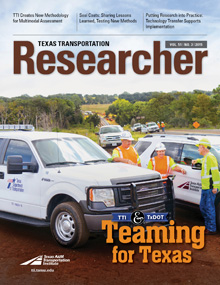Improving transportation safety for Texans is a goal long shared by the Texas Department of Transportation (TxDOT) and the Texas A&M Transportation Institute (TTI). In 2015, three projects are continuing that tradition of making the roadways in the Lone Star State safer for everyone.
TTI Develops Assessment Methodology for Rural Texas
Armed with a new approach for saving lives on rural roadways, TxDOT has launched an extensive pavement-widening project using a risk assessment methodology developed by researchers at TTI.

Previously, roadway improvements were made solely based on crash frequency. TTI researchers have developed a new way to identify roadway features that indicate where crashes are likely to occur. The methodology has never been used before in Texas.
“This systemic approach will allow TxDOT to improve roadway safety proactively by identifying a particular roadway based on its risk factors that have potential for crashes,” says TTI Crash Analysis Program Manager Troy Walden, principal investigator on Developing Methodology for Identifying, Evaluating and Prioritizing System Improvements. Wider pavement on rural roadways reduces the number of crashes and fatalities.
After a thorough examination of crashes on rural Texas highways from 2009 to 2013, researchers analyzed the numerous features of the roadways where the crashes occurred, including lane and shoulder width, the amount of truck traffic, and the degrees of curvature. Each factor was assigned points.
“By using this weighted method, TxDOT can add the details associated with each individual roadway and rank them,” Walden explains. “Once the roadways in question are compared to each other, TxDOT can prioritize its road-widening projects.”
Each TxDOT district has begun the ranking process using the new TTI methodology. Soon, those roadways will be prioritized for their pavement-widening needs, with work beginning next year. TxDOT plans to spend $15.5 million a year to widen rural roadways through 2019.
“I see this as an opportunity for us to get ahead of the crashes, to prevent them from happening,” says Safety Engineer Darren McDaniel of TxDOT’s Traffic Operations. “This method allows us to compare risk factors of roadway characteristics that tell us where the best opportunity is for improving safety.”
Gearing Up for Motorcycle Safety
In Texas, there are two types of motorcyclists — those that will wear helmets and those that won’t. However, when it comes to convincing riders to wear protective gear each time they ride, TTI researchers think some minds can be changed.

“We know that protective gear — like padded jackets and riding pants, eyewear, gloves, and boots — go a long way in reducing severe injuries,” says Mike Manser, TTI Human Factors Program manager, who’s studying how motorcyclists make those decisions. “But why motorcyclists decide to wear gear or not is something we don’t fully understand.”
Funded by TxDOT, the study began with a survey asking motorcyclists about the equipment they do wear and why they choose to wear it. From the results, TTI and TxDOT produced a tip card that focuses on the advantages of wearing safety gear. Now, researchers are reviewing the results of an online survey that was taken by 1,600 motorcyclists across the country. The final goal is an outreach campaign designed to convince riders that they should wear protective clothing each time they ride.
“Based on their answers, we will develop a campaign that shows the advantages of wearing safety equipment and motivates riders to change their habits. TxDOT has always been very concerned about motorcycle safety, and like me, they know that the more riders who wear gear, the better,” Manser says.
Attitude and Awareness Surveys for Texas Motorists
How often do Texans drive after drinking alcohol? How often do they drive over the speed limit? Do Texans know that everyone riding in a vehicle is required to buckle up?

Since 2010, those have been among the questions answered each year by at least 2,000 respondents in a traffic safety survey commissioned by TxDOT and distributed and analyzed by TTI.
“The anonymous survey is one of the ways in which TTI works with TxDOT to refine its highway safety program,” explains Katie Womack, manager of the Behavioral Research Group in TTI’s Center for Transportation Safety. “It’s a valuable tool designed to measure and track Texans’ attitudes and awareness of traffic safety programs, proposed policy changes, current laws, and behaviors related to issues such as impaired driving, distracted driving, safety belt use and others.”
Ten of the 25 survey questions are performance metrics specified by the National Highway Traffic Safety Administration, ten are traffic safety related and of specific interest to TxDOT, and five are designed to obtain background and demographic information. The 2015 Traffic Safety Attitude and Awareness Survey was conducted during the summer and is currently being analyzed. The final report will be released in 2016.
